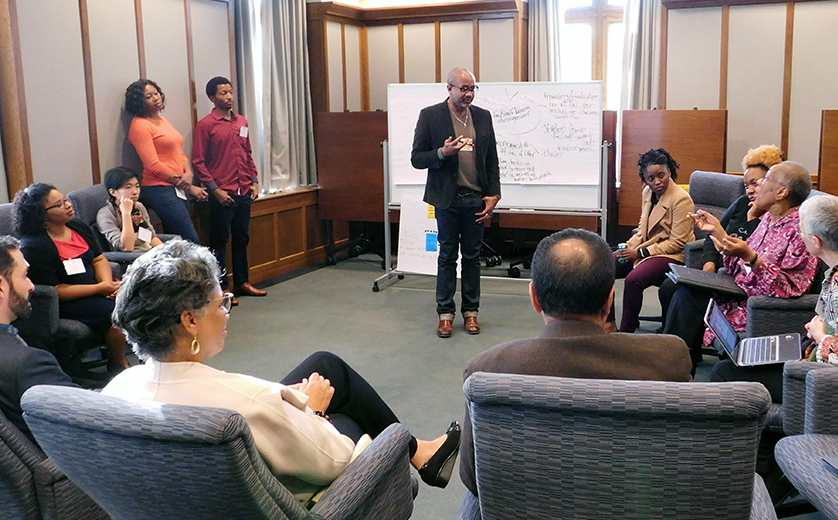Researchers, practitioners, community members and students from across the United States convened at the Brown School, Nov. 11, to share information and discuss the challenges to the mental health and emotional well-being of college students of color.
It was the third annual “Young, Gifted & @Risk” conference by the Steve Fund, a national nonprofit focused on promoting the emotional and mental health of students of color. The Brown School partnered with the Steve Fund to organize the day-long conference, which was attended by nearly 200 participants.
Research shows that students of color are less likely to seek help when depressed, and twice as likely to say they are less prepared emotionally for college than their peers. The issue is particularly present at predominantly white institutions like Washington University in St. Louis.
“This is forcing us to think about how diverse groups experience the same place very differently,” said Atia Thurman, manager of Brown School initiatives, who coordinated planning for the meeting under the leadership of Sean Joe, associate dean for faculty and research.
Following presentations by national experts on student mental health, the conference attendees subdivided into breakout sessions according to their roles and identity groups, such as students, families, faculty, veterans, administrators and counselors. Maya Terry, a first-year undergraduate student from New York, facilitated the student breakout session.
“The thing that surprised me most was that I was pretty much the only undergrad there,” she said. Because the onset of mental illness often occurs around the age of 18, spreading awareness among younger students would be a good idea, she said. Her breakout group recommended incorporating mental health into an online module that incoming students would be required to complete, similar to existing modules on drug and alcohol abuse and sexual assault.
Terry, who is African-American, had attended a predominantly white small private school in New York since seventh grade. Still, the much larger scale of Washington University has been an adjustment. “It’s scarier to be around so many people you don’t know,” she said.
And while making new friends can be stressful for any student, she said, it can be a special challenge for students of color who may have “a fear of making friends outside of my race, a fear of not being accepted by people of a different race.”
Each of the breakout groups reconvened with the larger group to share their insights.
Suggestions included:
- Acting proactively to deal with students’ emotional issues.
- Meeting students where they are, rather than funneling them to counseling centers for help.
- Encouraging a culture that, as Thurman said, “doesn’t glorify being stressed out.”
- Increasing the diversity of counseling staff.
“It’s about making an educational experience truly equitable,” Thurman said.
She believes Washington University and the Brown School are well positioned to lead nationally on the topic. “We have the resources to be at the forefront,” she said, “of both the research and the practice.”
Making the university environment work better for more students will benefit students of color, as well as other underrepresented groups.
Harvey Fields, Washington University’s Assistant Dean for Student Success, said students from lower income backgrounds who are Pell Grant-eligible also experience the university differently.
“They stress more, they’re isolated more, they’re staying up all night more,” said Fields, who attended the conference. It was the first time Fields had learned of the Steve Fund, which was founded by the family of Steve Rose after losing him to mental illness.
“People have known anecdotally for a long while that minority students don’t access or benefit as much from mental health services,” he said. “Knowing that there is an organization that is looking at ways to structurally and systematically find out why, was very encouraging to me.”
Fields’s position was created in part to help meet the university’s stated goal of enrolling more Pell-eligible students. His role, he said, is to help build an infrastructure to assure a “full and fulfilling, enriching and engaging experience for traditionally underrepresented students, including students of color, and to help all undergraduates be successful.”
He said attendees at the conference were willing to “change the dynamic of the question” when thinking about incoming students. “The mindset of the university is to ask: ‘Is the student college-ready?’ We should be asking: ‘Are we student-ready?’” he said.
“I’m proud of Washington University’s very upfront commitment,” he said. “It is encouraging that our university recognizes the problem and is trying to do something about it.”
